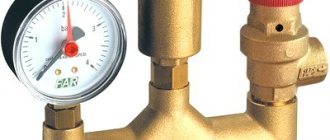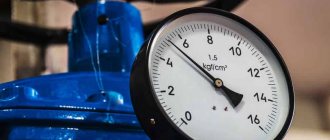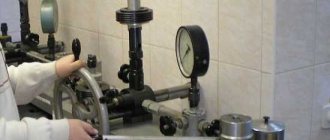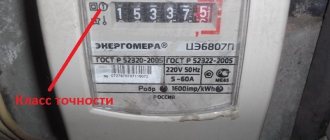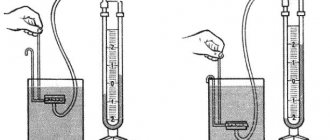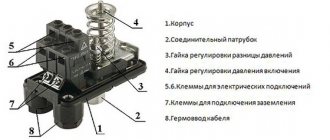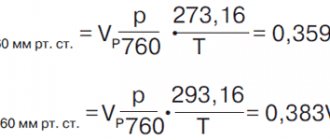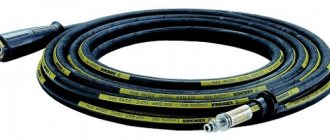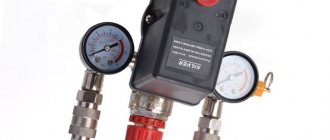Description of atmospheric pressure measuring instruments
06/19/2015
Air pressure varies widely. If it is more than 760 millimeters of mercury, then it is considered elevated
, if less, then
reduced
.
Observations of changes in atmospheric pressure make it possible to predict the weather. For example, when pressure increases in winter, the weather becomes frostier, and in summer it becomes hot.
Low atmospheric pressure contributes to cloudiness and precipitation.
Therefore, constantly knowing the value of atmospheric pressure and monitoring its changes is necessary not only for scientists and doctors, but for all of us.
Atmosphere pressure
Atmospheric pressure is measured in millimeters of mercury, as well as in Pascals and hectoPascals. Normal blood pressure is considered to be 760 mmHg. Art. (1013.25 hPa) .
Atmospheric pressure generally changes with changes in weather conditions. Often, pressure drops before inclement weather and rises before good weather. Keeping records of pressure changes allows you to determine the movement of cyclones and the direction of winds.
A change in characteristic pressure often does not affect the well-being of a person living for a long time in a certain area. In cases where non-periodic fluctuations in atmospheric pressure occur, even healthy people experience headaches, decreased performance and a feeling of heaviness in the body.
Changes in atmospheric pressure also affect many technological processes.
For example, when processing petroleum products, where pressure is one of the main controlled technical parameters; bakery production, where pressure readings greatly affect the moisture content of semi-finished dough products; in the aviation industry this is a very important parameter that affects the terms and conditions of operation.
Instruments for measuring atmospheric pressure
Today, there are several types of barometers that are used to measure air pressure:
- Mercury siphon barometer - represents a Y-shaped tube filled with mercury with an open and sealed end.
- Mercury cup barometer - consists of a vertical tube filled with mercury, the upper end of which is sealed, and the lower end is in a special cup with mercury.
- An aneroid barometer is an airless metal box with wavy walls.
- A barograph is a self-recording instrument that is used to monitor barometric pressure at certain periods of time.
- An electronic barometer is a digital device that operates on the principle of a conventional aneroid or on the principle of measuring air pressure on a sensitive crystal.
Mercury barometers are more accurate and reliable compared to aneroids; they are used to check the operation of other types of barometers. The height of pressure in them is determined by the height of the mercury column. Meteorological stations are equipped with cup barometers.
Measuring atmospheric pressure using a thermohygrometer
Atmospheric pressure is measured not only using various types of barometers, but also with such universal digital instruments as thermohygrometers.
Despite the fact that the main task of these devices is to determine relative humidity and temperature, they also do an excellent job of measuring air pressure, showing the most accurate values.
Therefore, such multifunctional devices are much more profitable to purchase than outdated barometers and psychrometers.
JSC "EXIS" brings to your attention a huge range of electronic pressure meters and other high-quality control and measuring instruments and always at affordable prices.
In particular, in our company you can purchase the following models of thermohygrometers:
- Thermohygrometer IVTM-7 M 2-D-V
. The device, in addition to measuring and recording temperature and relative humidity of air and other non-aggressive gases, measures atmospheric pressure in millimeters of mercury and hPa, can record data in non-volatile memory, recalculate measurement results into various units (percentage of relative humidity, g/m3), carry out simultaneous indication of measured values. IVTM-7 M 2-D-V has a high degree of dust and moisture protection (IP65), making it possible to use it in rooms with high humidity. - Thermohygrometer IVTM-7 K-1
. The device measures atmospheric pressure in kPa, can recalculate the values of various humidity units, carry out simultaneous indication of measured values, record data on microSD, it is possible to connect various types of primary transducers. - Thermohygrometer IVTM-7 R-03-I-D
. The device is equipped with a liquid crystal indicator designed for visual monitoring of relative humidity, temperature and pressure values. It has small dimensions and an ergonomic body. - Thermohygrometer IVTM-7 M 6-D (in an ergonomic housing).
The device measures atmospheric pressure in kPa, can record data on a non-volatile memory card, recalculate measurement results into various units, and simultaneously display the measured values. It has an ergonomic body and a large and convenient display. - Thermohygrometer IVTM-7 M 3-D-V
. The device, in addition to measuring and recording temperature and relative humidity of air and other non-aggressive gases, measures atmospheric pressure in millimeters of mercury and hPa, can record data in non-volatile memory, recalculate measurement results into various units (percentage of relative humidity, g/m3), carry out simultaneous indication of measured values. Model IVTM-7 M3-D-V is intended for creating a measuring network. The degree of moisture protection of the housing and sensor is IP65, which makes it possible to use it in rooms with high humidity. - Thermohygrometer IVTM-7 M 6-D.
The device measures atmospheric pressure in kPa, can record data on a non-volatile memory card (microSD), recalculate measurement results into various units, and simultaneously display the measured values.
All models of thermohygrometers have a communication interface with a PC via USB, RS-232 and can be mounted on a wall.
Lada Granta › Logbook › 18. Checking the accuracy of tire pressure gauges
I have several tire pressure gauges in my garage and have long noticed that when checking the same wheel with different pressure gauges, the pressure readings differ.
I measure the same wheel. Periodically pumping up, I check that the same pressure gauge has not drained.
Result: No. 1. Plumbing pressure gauge, new. 1.9 bar. No. 2. Pressure gauge USSR. 1.6 bar. No. 3. Another USSR. 1.7 bar. No. 4. Pressure gauge Russia. 1.55 bar. No. 5. Heyner Stop pressure gauge, new. 1.95 bar. No. 6. Pump with pressure gauge, China. 1.95 bar. No. 7. Pump with pressure gauge, Russia. 1.7 bar.
I don’t know what to believe - there is not a single standard pressure gauge here. I will check the pressure using new pressure gauges (No. 1, 5).
Pressure measuring instruments
A tonometer is a medical device for measuring blood pressure (BP) and pulse rate. It is used in healthcare institutions and at home to determine the state of the cardiovascular system. In the absence of problems, blood pressure levels remain stable.
- Small pressure fluctuations up to 20 mm. Hg Art. for systolic or upper value and up to 10 mm. Hg Art. for diastolic or lower value within one day are possible and not dangerous. The reasons for fluctuations are varied: from stress and anxiety to physical activity and heavy meals.
- A prolonged deviation of blood pressure levels from standard values, especially if it goes beyond normal limits, is a possible signal of the development of the disease and requires an early visit to the doctor.
It is important to note that each person has their own optimal blood pressure range to feel their best. Knowing the optimal blood pressure range helps your doctor identify changes in your health.
To determine your pressure range at home, you need to purchase a wrist-mounted device for measuring human blood pressure "Omron". Remember: pressure different from the norm does not work for a healthy person. Even feeling normal in this case is an additional reason to seek medical attention. consultation.
Why measure blood pressure?
Heart attack, stroke, kidney failure, blindness are all precursors to hypertension. And there is only one way to avoid serious complications - to maintain normal blood pressure levels with the help of medications.
Hypertensive patients need a home blood pressure monitor to prevent the risk of possible complications. It is very important to measure blood pressure in a quiet environment to obtain the most accurate data.
The pressure readings of sick and healthy people are influenced not only by external factors and various diseases; age and gender are of particular importance.
According to the data shown in the table, blood pressure increases with age and this is normal, as the body ages and age-related changes occur that provoke disorders.
We remind you! The parameters shown in the table are average values. To determine the exact individual blood pressure level, you must regularly use the Omron home blood pressure monitor and consult a specialist.
Typical elements of devices for measuring pressure levels
The main components of mechanical and semi-automatic blood pressure meters:
- pressure gauge with scale / electronic monitor;
- shoulder cuff (pneumatic chamber in a fabric “sleeve” with fixing Velcro);
- rubber bulb with an adjustable deflation valve for pumping air into the cuff;
- phonendoscope;
- rubber tubes for air supply.
The main components of automatic blood pressure meters:
- electronic unit with display;
- cuff on the shoulder or wrist (pneumatic chamber in a fabric “sleeve” with Velcro fasteners);
- rubber tubes;
- batteries type AA (“finger”) or type AAA (“little finger”);
- network adapter.
Types of Omron tonometers
Mechanical pressure meters CS Medica (CS 106 without phonendoscope / with phonendoscope, CS 105, CS 107, CS 110 Premium).
A mechanical device determines blood pressure by heart beats on the arteries, and the results are displayed on a pressure gauge. Air is pumped into the cuff manually using a special bulb.
Advantages: high reliability, long service life and reasonable price of the pressure meter.
Disadvantages: requires the direct participation of a third party at all stages of measurement, but the human factor introduces some error into the measurement results, the magnitude of which depends on the professionalism of the person measuring.
Automatic shoulder pressure meters (Omron M2 Basic, M2 Basic with adapter, M2 Basic with universal cuff and adapter, Omron M2 Classic, M2 Classic with adapter, M3 Eco, Omron M3 Expert, M3 Comfort, M3 Family, M6 Comfort, Omron M6 , Mit Elite, Mit Elite Plus, M10-IT) Automatic wrist pressure meters (Omron R1, R2, R3 Opti, Omron R5 Prestige)
The operating principle of automatic devices: using a compressor, the device automatically pumps air into the cuff. The result of systolic, diastolic pressure and pulse rate are displayed.
Advantages: accuracy is not affected by the human factor (artificial intelligence pumps air into the cuff, adapting to the individual characteristics of a person), simple use without specific skills.
Disadvantages: error in determining blood pressure in patients with cardiovascular problems (take two or three measurements to avoid inaccuracies); high price, especially of those digital devices for measuring human blood pressure that have the maximum range of consumer functions. The possible error is 3 – 10 mmHg.
Semi-automatic pressure meters (Omron S1, M1 Compact, M1 Eco)
Blood pulsation in the artery is determined automatically, the results are displayed on a liquid crystal display, but the cuff must be filled with air using a rubber bulb.
Advantages: no need to independently calculate pressure readings, all results are in electronic form, excellent functionality at a low cost.
Disadvantages: small errors in blood pressure calculations; require human intervention to pump air into the cuff.
You can buy Omron muscle stimulators with delivery in Moscow and Russia from the official Omron online store in the Russian Federation. Free call within Russia: 8 (800) 333-53-39.
Measurement methods
Blood pressure is measured in two ways:
- Auscultatory (Korotkoff method) – listening to the pulse using a phonendoscope. The method is typical for mechanical devices.
- Oscillometric – the result is immediately displayed on the screen of an automatic device.
However, in both cases the principle of operation of tonometers is the same.
How to measure blood pressure correctly?
When measuring with mechanical instruments, you must follow the instructions:
- The first measurement is carried out in the morning, the second or third measurement is taken in the afternoon and evening (or only in the evening); 1-2 hours after eating and no earlier than 1 hour after smoking or drinking coffee.
- It is advisable to take 2-3 measurements and calculate the average blood pressure value.
- It is correct to take the measurement on your non-working hand (on your left if you are right-handed, and on your right if you are left-handed).
- When applying the cuff, its lower edge should be 2.5 cm above the cubital fossa. The measuring tube extending from the cuff is located in the middle of the elbow.
- The stethoscope should not touch the tonometer tubes. It should be located at the level of the 4th rib or heart.
- The air is pumped vigorously (slow results in pain).
- Air inlet from the cuff should flow slowly - 2 mmHg. per second (the slower the release, the higher the quality of the measurement).
- You should sit at the table, leaning on the back of the chair, with your elbow and forearm on the table so that the cuffs are level with the heart line.
When measuring blood pressure with an automatic device, you should also follow points 1-4 from the instructions above:
- You should sit at the table, calmly leaning on the back of the chair, with your elbow and forearm lying on the table so that the cuff is level with the line of the heart.
- Then press the Star/Stop button and the device will automatically measure your blood pressure, but at this time you should not talk or move.
Blood pressure cuff and its size
The cuffs for the blood pressure meter must be the right size for you; the accuracy of the readings directly depends on this (measure the circumference of your arm above the elbow).
The set of Omron pressure measuring devices includes various cuffs, so it is necessary to check the size and the possibility of connecting additional cuffs.
with mechanical devices:
- Enlarged nylon without fixing ring for shoulder circumference 24-42 cm.
- Nylon with a metal fixing ring for shoulder circumference 24-38 cm.
- Nylon with a metal fixing ring for shoulder circumference from 22-38 cm.
- Enlarged without a fixing bracket for shoulder circumference 22-39 cm.
Mechanical tonometers (except for the CS Medics CS 107 model) have the ability to connect 5 different additional cuffs:
- No. 1, type H (9-14 cm).
- No. 2, type D (13-22 cm).
- Medica No. 3, type P (18-27 cm).
- Medica No. 4, type S (24-42 cm).
- Medica No. 5, type B (34-50 cm).
The Omron Fan-Shaped fan-shaped cuff (22-32 cm) is supplied with semi-automatic However, these tonometers have the ability to connect additional cuffs, which are purchased separately:
- Small + small “pear” (17-22 cm).
- Large for arm circumference (32-42 cm).
included with automatic devices:
- Compression standard CM, repeating the shape of the hand, medium size, (22-32 cm).
- Large CL (32-42 cm).
- Children's CS2 (17-22 cm).
- Universal CW (22-42 cm).
- Innovative Omron Intelli Wrap cuff (22-42 cm).
- Compression, new generation Easy Cuff, repeating the shape of the hand (22-42 cm).
Professional automatic models HBP-1100, HBP-1300 are supplied with two cuffs: a medium compression cuff Omron GS Cuff M (22-32cm) and a large compression cuff Omron GS Cuff L (32-42cm). It is possible to additionally purchase cuffs in the following sizes:
- GS Cuff SS, extra small (12-18 cm).
- GS Cuff S, small (17-22 cm).
- Omron GS Cuff M (22-32 cm).
- GS Cuff XL, extra large (42-50 cm).
Criterias of choice
Before buying a device, you need to understand exactly what it is needed for and where it will be installed.
Important selection criteria:
- Measuring range. Rule: the working pressure in the pipeline should be no more than 2/3 of the maximum of the measurement scale, but not less than 1/3. If the pressure in the pipe is 5 atm, then you need to buy a pressure gauge with a scale of 0...10 atm.
- The accuracy class varies from 0.15 to 3. The lower, the more accurate. For a cold or hot water supply system, an accuracy of 1.5% is sufficient.
- The location of the fitting can be radial or end when it is from below; and axial or frontal, when he is behind.
- Operating temperature range.
- Temperature operating conditions.
- Working medium (water, steam, oil and so on);
- Diameter. It should be such that the device fits in the chosen location and the dial is clearly visible.
It is also necessary to pay attention to the connecting thread of the fitting. It can be metric - its parameters are measured in mm, denoted by the letter M, for example M20/1.5, which means the outer diameter is 19.9 mm, the inner diameter is 18.7 mm, pitch 1.5. Domestic manufacturers use it by default.
Domestic manufacturers use it by default.
Pipe thread is designated by the letter G. G1/2" means an outer diameter of 20.9 mm, an inner diameter of 18.6, a pitch of 1.8 mm or 14 threads per inch.
The technical passport of a new device must contain a factory verification mark. A verification period of less than a year confirms that the device gives correct readings.
What device measures excess pressure?
The characteristic of pressure is the force that uniformly acts on a unit surface area of the body. This force influences various technological processes. Pressure is measured in pascals. One pascal is equal to a force of one newton applied to a surface area of 1 m2. Instruments are used to measure pressure.
Types of pressure
- Atmospheric pressure is generated by the Earth's atmosphere.
- Vacuum pressure is pressure that does not reach atmospheric pressure.
- Excess pressure is a pressure value that exceeds atmospheric pressure.
- Absolute pressure is determined from the value of absolute zero (vacuum).
Types and work
Devices that measure pressure are called pressure gauges. In technology, it is most often necessary to determine excess pressure.
A significant range of measured pressure values and special conditions for measuring them in various technological processes determine the variety of types of pressure gauges, which have their own differences in design features and operating principles. Let's consider the main types used.
Barometers
A barometer is a device that measures air pressure in the atmosphere. There are several types of barometers.
A mercury barometer works by moving mercury in a tube along a specific scale.
A liquid barometer works on the principle of balancing a liquid with atmospheric pressure.
An aneroid barometer works by changing the dimensions of a sealed metal box with a vacuum inside, under the influence of atmospheric pressure.
An electronic barometer is a more modern device. It converts the parameters of a conventional aneroid into a digital signal, which is displayed on a liquid crystal display.
Liquid pressure gauges
In these models of devices, the pressure is determined by the height of the liquid column, which equalizes this pressure. Liquid devices for measuring pressure are most often made in the form of 2 glass vessels connected to each other, into which liquid (water, mercury, alcohol) is poured.
Fig-1
One end of the container is connected to the medium being measured, and the other is open. Under the pressure of the medium, the liquid flows from one vessel to another until the pressure equalizes. The difference in fluid levels determines the excess pressure. Such devices measure pressure difference and vacuum.
Figure 1a shows a 2-pipe pressure gauge that measures vacuum, gauge and atmospheric pressure. The disadvantage is the significant error in measuring pressures that have pulsation. For such cases, 1-pipe pressure gauges are used (Figure 1b). They contain one edge of a larger vessel. The cup is connected to the cavity being measured, the pressure of which moves the liquid into the narrow part of the vessel.
When measuring, only the height of the liquid in the narrow elbow is taken into account, since the liquid changes its level in the cup insignificantly, and this is neglected. To measure small excess pressures, 1-pipe micromanometers with a tube inclined at an angle are used (Figure 1c). The greater the inclination of the tube, the more accurate the readings of the device, due to the increase in the length of the liquid level.
A special group is considered to be devices for measuring pressure, in which the movement of liquid in a container acts on a sensitive element - a float (1) in Figure 2a, a ring (3) (Figure 2c) or a bell (2) (Figure 2b), which are connected to an arrow, which is a pressure indicator.
Fig-2
The advantages of such devices are remote transmission and recording of values.
Strain gauges
In the technical field, strain gauges for measuring pressure have gained popularity. Their operating principle is to deform the sensing element. This deformation occurs under the influence of pressure. The elastic component is connected to a reading device having a scale graduated in pressure units. Deformation pressure gauges are divided into:
- Spring.
- Bellows.
- Membrane.
Fig-3
Spring pressure gauges
In these devices, the sensitive element is a spring connected to the pointer by a transmission mechanism. Pressure acts inside the tube, the cross-section tries to take a round shape, the spring (1) tries to unwind, as a result the pointer moves along the scale (Figure 3a).
Diaphragm pressure gauges
In these devices, the elastic component is the membrane (2). It bends under pressure and acts on the arrow using a transmission mechanism. The membrane is made like a box (3). This increases the accuracy and sensitivity of the device due to greater deflection at equal pressure (Figure 3b).
Bellows pressure gauges
In bellows-type devices (Figure 3c), the elastic element is a bellows (4), which is made in the form of a corrugated thin-walled tube. Pressure is applied to this tube. At the same time, the bellows increases in length and, with the help of a transmission mechanism, moves the pressure gauge needle.
Bellows and membrane types of pressure gauges are used for measuring minor excess pressures and vacuum, since the elastic component has little rigidity.
When such devices are used to measure vacuum, they are called draft gauges .
The device that measures excess pressure is a pressure gauge pressure gauges are used to measure excess pressure and vacuum .
Devices for measuring pressure of the deformation type have an advantage over liquid models. They allow readings to be transmitted remotely and recorded automatically.
This occurs due to the conversion of the deformation of the elastic component into an electrical current output signal. The signal is recorded by measuring instruments that are calibrated in pressure units. Such devices are called strain-electric manometers. Strain gauge, differential transformer and magnetic modulation converters are widely used.
Differential transformer converter
Fig-4
The principle of operation of such a converter is to change the induction current depending on the pressure value.
Devices with such a converter have a tubular spring (1), which moves the steel core (2) of the transformer, and not the arrow. As a result, the strength of the induction current supplied through the amplifier (4) to the measuring device (3) changes.
Magnetomodulation devices for measuring pressure
In such devices, the force is converted into an electric current signal due to the movement of a magnet associated with an elastic component. When moving, the magnet acts on the magnetic modulation converter.
The electrical signal is amplified in a semiconductor amplifier and sent to secondary electrical measuring devices.
Strain gauges
Converters based on a strain gauge operate on the basis of the dependence of the electrical resistance of the strain gauge on the amount of deformation.
Fig-5
Strain gauges (1) (Figure 5) are fixed on the elastic element of the device. The electrical signal at the output arises due to a change in the resistance of the strain gauge, and is recorded by secondary measuring devices.
Electric contact pressure gauges
Electrical contact pressure gauges have become popular in alarm circuits, automatic process control systems, and thermal protection devices. The figure shows a diagram and view of the device.
Fig-6
The elastic component in the device is a tubular single-turn spring. Contacts (1) and (2) are made for any marks on the instrument scale by rotating the screw in the head (3), which is located on the outside of the glass.
Pressure measuring instruments
Standard level
Often a cyclist does not know to what level he needs to inflate the tires of his bike. This usually happens when purchasing tires with “unclear” markings or without them. This situation occurs quite often when, in search of cheapness, a person buys bicycle tires from an unknown manufacturer, the cost of which can be an order of magnitude lower than that of branded bicycle tires - “Continental” (Germany), “Michelin” (France), “Vittoria” (Italy) ) or "TUFO" (Czech Republic). In this case, you should use one of the tables, many available on specialized Internet resources.
For example, the standard pressure range for a bike of the “All mountain” or “Cross-country” category can be found in the table.
For a road bike, this tire value is chosen slightly higher and can be found from the corresponding tables on the Internet, but in any case you should not exceed the upper limit in PSI.
